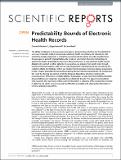| dc.contributor.author | Dahlem, Dominik | |
| dc.contributor.author | Maniloff, Diego | |
| dc.contributor.author | Ratti, Carlo | |
| dc.date.accessioned | 2015-07-07T15:42:11Z | |
| dc.date.available | 2015-07-07T15:42:11Z | |
| dc.date.issued | 2015-07 | |
| dc.date.submitted | 2013-12 | |
| dc.identifier.issn | 2045-2322 | |
| dc.identifier.uri | http://hdl.handle.net/1721.1/97694 | |
| dc.description.abstract | The ability to intervene in disease progression given a person’s disease history has the potential to solve one of society’s most pressing issues: advancing health care delivery and reducing its cost. Controlling disease progression is inherently associated with the ability to predict possible future diseases given a patient’s medical history. We invoke an information-theoretic methodology to quantify the level of predictability inherent in disease histories of a large electronic health records dataset with over half a million patients. In our analysis, we progress from zeroth order through temporal informed statistics, both from an individual patient’s standpoint and also considering the collective effects. Our findings confirm our intuition that knowledge of common disease progressions results in higher predictability bounds than treating disease histories independently. We complement this result by showing the point at which the temporal dependence structure vanishes with increasing orders of the time-correlated statistic. Surprisingly, we also show that shuffling individual disease histories only marginally degrades the predictability bounds. This apparent contradiction with respect to the importance of time-ordered information is indicative of the complexities involved in capturing the health-care process and the difficulties associated with utilising this information in universal prediction algorithms. | en_US |
| dc.description.sponsorship | General Electric Company | en_US |
| dc.description.sponsorship | AT&T Foundation | en_US |
| dc.description.sponsorship | National Science Foundation (U.S.) | en_US |
| dc.description.sponsorship | American Society for Engineering Education. National Defense Science and Engineering Graduate Fellowship | en_US |
| dc.description.sponsorship | Audi Volkswagen | en_US |
| dc.language.iso | en_US | |
| dc.publisher | Nature Publishing Group | en_US |
| dc.relation.isversionof | http://dx.doi.org/10.1038/srep11865 | en_US |
| dc.rights | Creative Commons Attribution | en_US |
| dc.rights.uri | http://creativecommons.org/licenses/by/4.0/ | en_US |
| dc.source | Nature | en_US |
| dc.title | Predictability Bounds of Electronic Health Records | en_US |
| dc.type | Article | en_US |
| dc.identifier.citation | Dahlem, Dominik, Diego Maniloff, and Carlo Ratti. “Predictability Bounds of Electronic Health Records.” Scientific Reports 5 (July 7, 2015): 11865. | en_US |
| dc.contributor.department | Massachusetts Institute of Technology. Department of Urban Studies and Planning | en_US |
| dc.contributor.department | Massachusetts Institute of Technology. SENSEable City Laboratory | en_US |
| dc.contributor.mitauthor | Dahlem, Dominik | en_US |
| dc.contributor.mitauthor | Maniloff, Diego | en_US |
| dc.contributor.mitauthor | Ratti, Carlo | en_US |
| dc.relation.journal | Scientific Reports | en_US |
| dc.eprint.version | Final published version | en_US |
| dc.type.uri | http://purl.org/eprint/type/JournalArticle | en_US |
| eprint.status | http://purl.org/eprint/status/PeerReviewed | en_US |
| dspace.orderedauthors | Dahlem, Dominik; Maniloff, Diego; Ratti, Carlo | en_US |
| dc.identifier.orcid | https://orcid.org/0000-0003-2026-5631 | |
| mit.license | PUBLISHER_CC | en_US |
| mit.metadata.status | Complete | |
